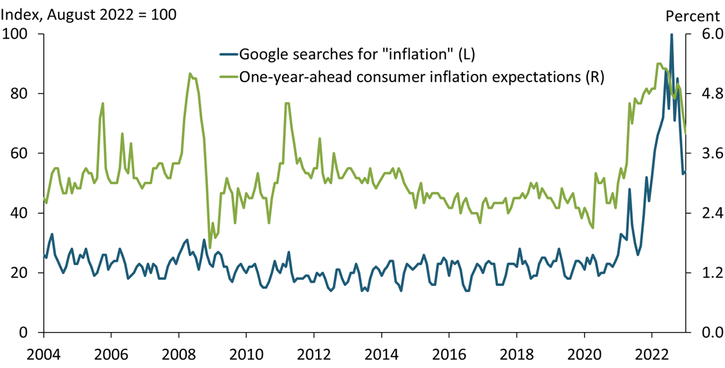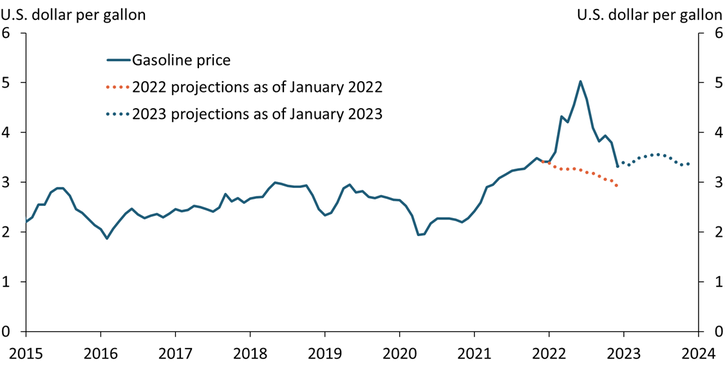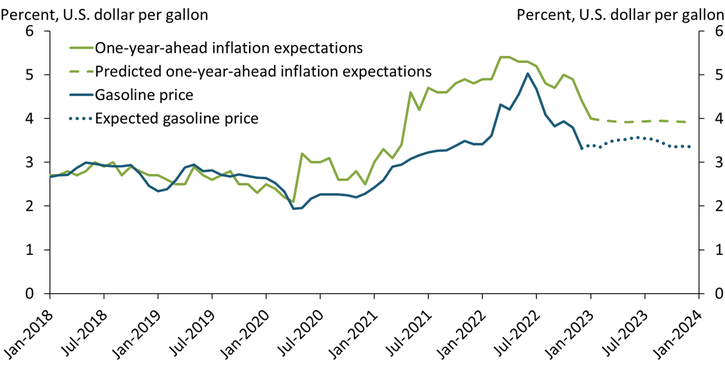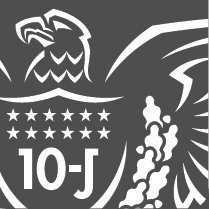Gasoline prices hit at an all-time high of more than $5 per gallon in the summer of 2022. This historic rise in gasoline prices helped push inflation as measured by the Consumer Price Index (CPI) to 9.1 percent in June, the highest rate of U.S. inflation in more than 40 years. The run-up in gasoline prices, and prices more generally, heightened public scrutiny around inflation after years of little public interest. For example, the blue line in Chart 1 shows that in August 2022, Google searches for “inflation” hit their highest level since the data series began in 2004. The commensurate rise in inflation expectations (green line) has been particularly concerning for Federal Reserve policymakers tasked with price stability, a mandate they have interpreted as 2 percent inflation over the longer run. In a 2022 speech at the Jackson Hole Economic Policy Symposium, Federal Reserve Chair Jerome Powell noted that high inflation requires consumers to incorporate inflation into everyday decisions, raising the risk that high inflation expectations could become entrenched and pose a threat to the Fed’s pursuit of price stability.
Chart 1: The public became much more attuned to inflation in 2022

Note: Google “inflation” searches are normalized to 100 at the peak.
Sources: Google Trends and University of Michigan (Haver Analytics).
Consumers’ inflation expectations are a key determinant of actual inflation. For example, higher inflation expectations can lead workers and businesses to demand higher wages and prices in anticipation of higher costs (see, for example, Glover, Mustre-del-Río, and von Ende-Becker 2023). Moreover, if households expect higher inflation in the future, they may choose to make big-ticket purchases such as household appliances today, thereby pulling forward future demand and driving up actual inflation. One important factor shaping households’ inflation expectations is price changes in the goods consumers purchase most often (see, for example, Brachinger 2008 and D’Acunto and others 2021). Gasoline is one such salient good, the price of which consumers frequently observe at retail gasoline stations. Unsurprisingly, gas prices have a strong relationship with households’ inflation expectations. Indeed, Coibion and Gorodnichenko (2015) show that energy prices—operating through consumers’ inflation expectations—can strongly influence inflation.
The effect that gasoline price changes have on inflation expectations, and hence inflation, can be amplified when inflation is already high and consumers are closely scrutinizing the prices they pay for everyday essentials. In Çakır Melek, Dillon, and Smith (2022), we analyze nearly 40 years of data on consumer inflation expectations each month across hundreds of respondents to the University of Michigan Survey of Consumers, to ask whether consumer inflation expectations are more sensitive to changes in gasoline prices in high-inflation environments. We show that in response to a change in the price of gasoline, individuals with higher initial inflation expectations revise their inflation expectations by almost twice as much as those with lower initial inflation expectations. We find a similar pattern of increased sensitivity of inflation expectations to gasoline price changes following periods when CPI inflation has been elevated. This research suggests that declining gasoline prices could yield greater reductions in inflation expectations when overall inflation is high, as it still is.
Declining gas prices have indeed played a large role in lowering inflation from its multi-decade highs last summer. For example, in the second half of 2022, falling energy prices were the primary component lowering headline CPI inflation. Chart 2 shows that although gasoline prices are still higher in January 2023 than they were projected to be a year ago (shown by the orange dotted line), they declined significantly in the second half of 2022 amid slowing global growth and higher-than-expected oil supply. In the current high-inflation environment, in which consumers are increasingly focused on changes in salient prices, the sizeable drop in gasoline prices since June 2022 significantly dampened inflation expectations. Indeed, based on our analysis in Çakır Melek, Dillon, and Smith (2022), we find that 40 percent of the decline in one-year-ahead inflation expectations can be attributed to the decline in gasoline prices from September to December 2022.
Chart 2: After reaching an all-time high last summer, gasoline prices declined

Note: Gasoline price projections, shown by the dotted lines, are from the Short-Term Energy Outlook.
Source: Energy Information Administration.
However, gasoline prices are unlikely to provide further relief to inflationary pressures going forward. The blue dotted line in Chart 2 shows projected gasoline prices as of January 2023, suggesting gasoline prices will remain relatively stable through the end of 2023. Although the January 2022 projection underscores the unexpected turns that energy markets can take, if the January 2023 projection were to materialize, then gasoline prices would be around $3.40 per gallon by the end of 2023, not far from their December 2022 level. This relative stability in gasoline prices would also lead to stability in one-year-ahead inflation expectations in 2023. The green dashed line in Chart 3 shows that under a relatively stable gasoline price scenario, predicted one-year-ahead inflation expectations would be relatively stable around 4 percent, above pre-pandemic levels. Together, these findings suggest that the effect of gasoline prices on inflation, both directly and through near-term inflation expectations, is likely to be neutral going forward.
Chart 3: Relatively stable gasoline prices could bring relatively stable one-year-ahead inflation expectations

Notes: The gasoline price projection is from the January 2023 Short-Term Energy Outlook. Predicted one-year-ahead inflation expectations are based on the coefficient estimates of different inflation expectation groups presented in Çakır Melek, Dillon, and Smith (2022).
Sources: Energy Information Administration, University of Michigan, and authors’ calculations.
In sum, a decline in gasoline prices when inflation is high can have an outsized effect in lowering consumer inflation expectations, as it did late last year. However, no further relief at the pump is expected in 2023. If gasoline prices remain relatively stable through 2023, as expected in January 2023, they are unlikely to deliver additional support in returning inflation back to the Fed’s 2 percent target.
References
Brachinger, Hans Wolfgang. 2008. “External LinkA New Index of Perceived Inflation: Assumptions, Method, and Applications to Germany.” Journal of Economic Psychology, vol. 29, no. 4, pp. 433–457.
Çakır Melek, Nida, Francis Dillon, and A. Lee Smith. 2022. “External LinkCan Higher Gasoline Prices Set Off an Inflationary Spiral?” Federal Reserve Bank of Kansas City, Economic Review, vol. 107, no. 4, pp. 41–57.
Coibion, Olivier, and Yuriy Gorodnichenko. 2015. “External LinkIs the Phillips Curve Alive and Well after All? Inflation Expectations and the Missing Disinflation.” American Economic Journal: Macroeconomics, vol. 7, no. 1, pp. 197–232.
D’Acunto, Francesco, Ulrike Malmendier, Juan Ospina, and Michael Weber. 2021. “External LinkExposure to Grocery Prices and Inflation Expectations.” Journal of Political Economy, vol. 129, no. 5, pp. 1615–1639.
Glover, Andrew, José Mustre-del-Río, and Alice von Ende-Becker. 2023. “External LinkHow Much Have Record Corporate Profits Contributed to Recent Inflation?” Federal Reserve Bank of Kansas City, Economic Review, vol. 108, no. 1.
Nida Çakır Melek is a senior economist, Francis M. Dillon is a research associate, and A. Lee Smith is a senior vice president and economist at the Federal Reserve Bank of Kansas City. The views expressed are those of the authors and do not necessarily reflect the positions of the Federal Reserve Bank of Kansas City or the Federal Reserve System.
